There’s a classic Ed Abbey story, told to me not long after his death, by an old musician friend of Ed’s, known to some as Swarthy Fortknocker. Swarthy was in Tucson visiting the Abbey family and suggested that he and Abbey pay a visit to one of the local establishments that provided adult beverages. Ed’s deteriorating health had forced him to give up ardent spirits but he liked the idea anyway; if nothing else he longed for the ambience. They decided to visit one of the more upscale clubs in town, a bar that catered mainly to the professional crowd—the “yuppies (Young Urban Professionals as they were known in the 80s). It was an especially appealing watering hole for members of the legal community, who often gathered there to talk about their cases and to brag about the shamelessly exorbitant price they could extract for “billing hours.” Abbey was all too familiar with lawyers, especially those that represented his ex-wives, who were frequently in pursuit of Ed for back alimony.
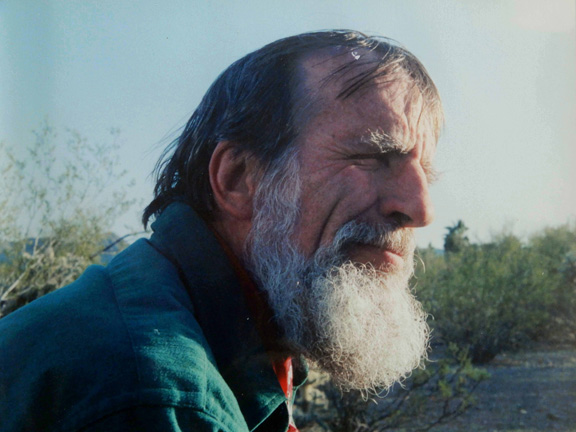
As they entered the bar and into its dimly lit and smoky, but elegant surroundings, Abbey couldn’t help but notice the stylishly attired “professionals,” who sat at small candle lit tables, adorned in their three-piece suits and gold watch chains. There weren’t as many female attorneys in those days, but the women who had entered the profession were nattily clad as well. They dressed in smart but eye-catching suits, the kind of ‘look’ that could even turn the eyes of a jury. Of course, elegant women always turned Abbey’s head and he could not help but notice. In fact, secretly, it was another reason he chose this kind of environment to at least observe the crowd with Swarthy, even if he limited his own libations to a Perrier on the rocks.
Still this was Abbey—the author who had built a reputation and a career insulting his adversaries and friends alike. Abbey had failed to dress for the occasion. He could not help but draw a few stares when the front door swung open and Cactus Ed appeared. He was sporting his ancient sweat stained, wide-brimmed sombrero, adorned with the unique pull-tab beer can hat band, a ratty Earth First! T-shirt and a worn out pair of jeans. The only aspect of his appearance that made him tolerable was that Swarthy had managed to “dress down” even more. A tank top, a pair of cutoffs, and flip-flops, that exposed a rather severe case of toenail fungus, clearly delineated Swarthy from the regular clientele.
Abbey paused, rather dramatically in the open door, gathered in the scene, and said to Swarthy in a voice that carried all the way to the far tables, “You know Swarth…it smells like LAWYERS in here!”
He flashed his famous toothy grin and waited for a response. Abbey was easily recognized in Tucson–he had celebrity status there, in fact— and many of the clientele roared with laughter. Some even agreed with him. They knew he loved to stir the shit. A few of the more humorless legal minds scowled.
///
In these extremely polarized times, where a simple difference of opinion can destroy a lifetime friendship in the blink of an eye, some might argue that Edward Abbey was almost a prototype for polarizing rhetoric. That he was a role model for the poison pen and the cheap shot, decades before it almost became a way of life for so many of us on social media in the 21st Century. It’s true that Ed picked a lot of targets and made some enemies, sometimes of his own doing. But if you really knew Abbey, you’d understand the difference between being a polarizer and a provocateur. Abbey was more the latter, and a self-proclaimed trouble-maker with an often self-deprecating sense of humor at that. He was a quipster who sometimes failed to see the connection between his clever asides and the pain it might inflict, especially among his friends. And that’s the point—while Abbey casually tossed darts at the world, his friends were far more diverse than most of his readers would have guessed.
But it was after all, Abbey who insulted the entire Western ranching industry with his frequent rants about the “welfare cowboys” and their “stinking bovines,” though he was shocked, saddened, and even bewildered when he received angry letters from dear friends who were ranchers themselves.
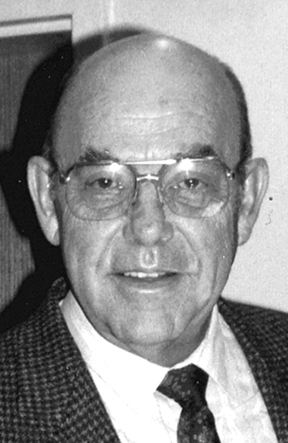
He once wrote that “there is nothing smaller than a small businessman,” though it didn’t occur to him at the time that a best friend like Ken Sleight, who ran a small river running outfit, was a small businessman himself. Sam Taylor, who published the local Moab paper for decades was especially offended. When he complained to Ed, Abbey meekly replied that “I wasn’t talking about you, Sam.”
And so, when it came to lawyers, though he had brazenly proclaimed that all members of the legal profession possessed a certain aroma, one of Ed’s buddies during his years living in Moab was my best friend for decades, lawyer Bill Benge.
Bill was, in every way, the polar opposite of Abbey. Their upbringing, their lifestyles and educational backgrounds could not have been more different. Ed grew up in rural Pennsylvania, chopped wood for heat and preferred the outdoors, loathed the coat and tie and was hitchhiking and riding freight trains around the country when he was 17. Bill was raised in the Bay Area in California, in a fairly affluent and upper middle class environment. He was on the tennis team and went to the Senior prom and looked like so many of us Boomers from the 60s. He went to law school at Stanford (Boalt) and his father assumed he’d become a prominent San Francisco attorney.
But he and Abbey did have one common love —- the canyon country of Southeast Utah. I knew Bill for 30 years but I can’t remember what first brought him to Moab. But I know that he fell in love with the place, got a job with Tex McClatchy as a shuttle driver at Tex’s Riverways in 1973, and rented a little cottage in Moab on First North. He somehow met Abbey while hiking in the Needles and they both moved to Moab permanently in 1974. Ed and his wife Rene bought a ranch style home on Spanish Valley Drive and Ed and Bill built a friendship.
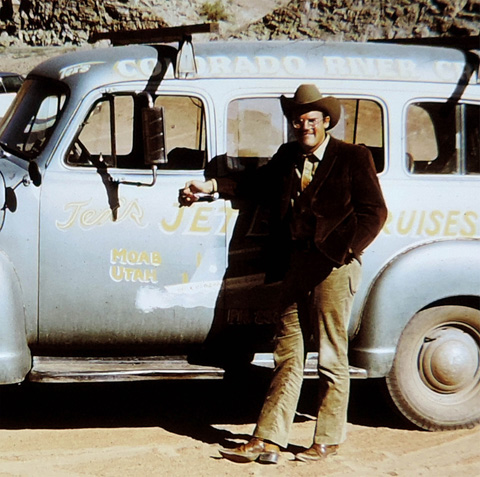
Incredibly, Ed Abbey himself was a tennis buff and had a finely tuned competitive spirit. The Moab tennis court that Abbey and Benge used to play out their grudge matches was in serious decay in 1974, full of cracks and potholes. Benge claimed that Abbey would aim for the cracks to give him the upper hand. Bill said that Abbey called those shots his “crevacer.”
Bill was also a brilliant chef–he could have abandoned the law and been much happier cooking in a 4-star restaurant. He loved to experiment and invited Ed and Rene’ to his home on several occasions to try out new recipes. He even kept his master cookbook with its “guest register” for his friends to “sign in.” Ed and Rene obliged.

///
In early 1971, Abbey started work on what he was sure to be the first of his “two future masterpieces.” In his journal on February 28, he mentioned the title for the first time when he wrote, “THE MONKEY WRENCH GANG RIDES AGAIN.” (the caps were his)
And there it sat. In October 1972, Abbey acknowledged that he had been gripped with writer’s block and had “not writ a word” in months. Finally, a year later, the creative juices began to flow and by the late summer of 1974, Abbey was 675 pages into the manuscript; by November, the end was in sight. Abbey’s agent was already pitching the novel to publishers.
It’s doubtful that anyone taking the time to read this has yet to read the “Monkey Wrench Gang,” so I don’t think there’s a need to do a spoiler’s alert. You know that after a long chase into the Maze, the Gang, with the exception of Hayduke, surrenders to the authorities who had been after them for months. But Abbey had little knowledge of the law, especially in Utah, but had attempted to ‘wing it’ when he detailed the legal actions that would have followed their arrest. But he wanted to be as accurate as possible, so he turned to his legal brain trust for help. Abbey wrote a short note to Bill Benge and included several pages from the chapter called “Epilogue: The New Beginning.”
Benge came to the rescue. On November 6, 1974, Bill sent a long reply to Ed, who was still in Moab and retrieving his mail at PO Box 66. Here are excerpts from that letter:
Dear Ed,
In regard to the portion of the book you asked me to read and also in regard to the questions you posed, I have the following comments:
If the parties were captured in Wayne County, they would at first be jailed in Wayne County. at the county seat of Loa. However, as soon as charges were pressed against them in San Juan County they would be transferred to the San Juan County jail in Monticello….
Bill then explained what the charges would most likely be, as Abbey described them in his narrative…
I would think it would be most likely that these people would be charged with State offenses and be tried in Monticello. The title of the action would be The State of Utah vs _____________________ . In the State Court they would probably be charged with conspiracy, a felony; assault with a deadly weapon, a felony; simple assault with the hot coffee, a misdemeanor; arson; aggravated arson, a felony; interfering with arrest, a misdemeanor; obstructing justice, a misdemeanor; escape from official custody, a felony. In view of these numerous offenses, I would say that these individuals’ bail could be as much as $25,000 each. I do believe there would be a jury trial involved here, and they would be tried together, for these offenses…
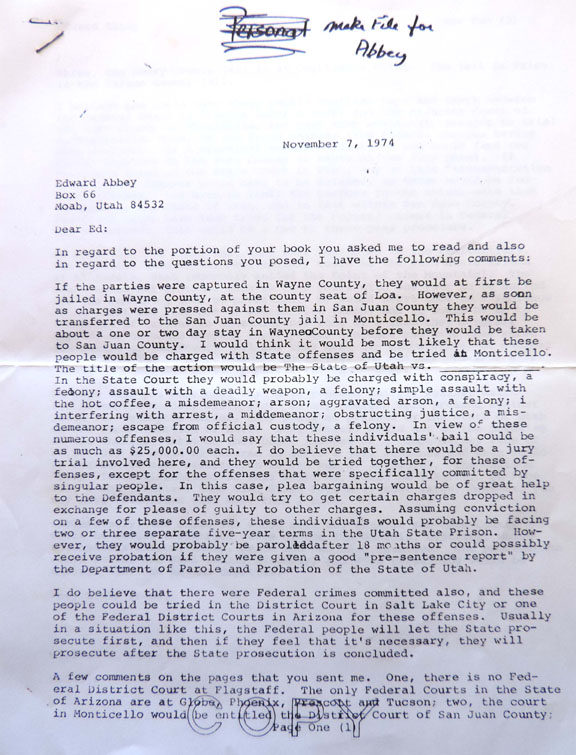
Bill offered his professional opinion regarding possible jail time…
Assuming conviction on a few of these offenses, these individuals would probably be facing two or three five-year terms in the Utah State Prison. However, they would probably be paroled after 18 months or could possibly receive probation if they were given a good “pre-sentence report” by the Department of Parole and Probation of the State of Utah.
I do believe that there were federal crimes committed also, and these people could be tried in the District Court of Salt lake City or one of the Federal District Courts in Arizona…Usually in a situation like this, the federal people will let the State prosecute first, and then if they feel it’s necessary, they will prosecute after the State prosecution has ended.
And then Bill really got into the weeds with Abbey’s narrative, finding every minor error that he saw, which of course is exactly what Abbey wanted him to do. Here are some of Benge’s corrections and edit suggestions…
A few comments on the pages you sent me. One, there is no federal District Court in Flagstaff. The only Federal Courts…are in Globe, Phoenix, Prescott and Tucson; two, the court in Monticello would be entitled (sic) the District Court of San Juan County; three, the Emery County jail is in Castledale, Utah. The jail in Price is the Carbon County jail.
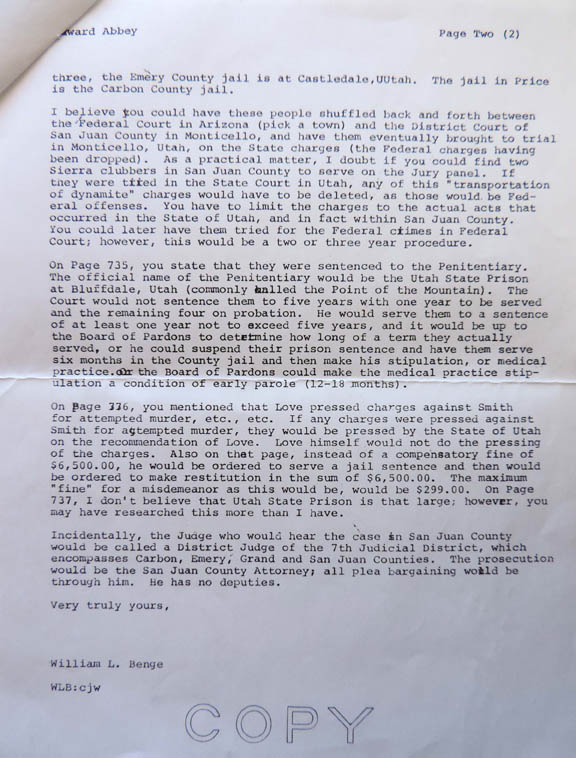
I believe you could…have the eventually brought to trial in Monticello, Utah, on the State charges (the federal charges having been dropped). As a practical matter, I doubt if you could find two Sierra Clubbers in San Juan County to serve on the Jury panel. If they tried in the State Court of Utah, any of the “transportation of dynamite” charges would have to be deleted, as those would be federal offenses. You have to limit the charges to the actual acts that occurred in the State of Utah, and in fact within San Juan County. You could later have them tried for the federal crimes in federal Court; however this would be a two or three year procedure.
On page 735, you state that they were sentenced to the Penitentiary. The official name…would be the Utah State Prison at Bluffdale (commonly called the Point of the Mountain). The Court would not sentence them to five years with one year to be served and the remaining four on probation. He would serve them to a sentence of one year not to exceed five years, and it would be up to the Board of Pardons to determine how long of a term they actually served…
On page 776, you mentioned that Love pressed charges against Smith for attempted murder, etc., etc. If any charges were pressed against Smith for attempted murder, they would be pressed by the State of Utah on the recommendation of Love. Love himself would not do the pressing of charges.
Incidentally, the Judge who would hear the case in San Juan County would be called the District Court Judge of the 7th Judicial District, which encompasses Carbon, Emery, Grand and San Juan Counties. The prosecution would be the San Juan County Attorney; all plea bargaining would be through him. He has no deputies.
Very truly yours,
William L. Benge
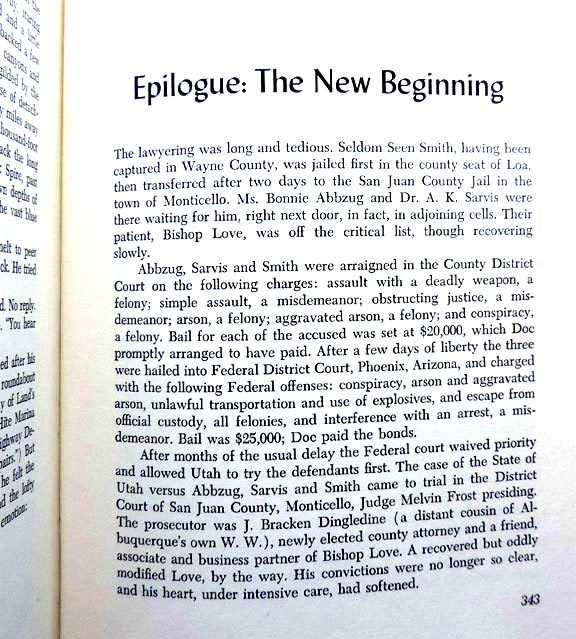
Abbey took Bill’s letter to heart and went back to the chapter in question. His revisions were clearly reflected, almost word for word, starting on page 343 of the original Lippincott hardcover chapter called, “Epilogue: The New Beginning.” And as we all know, Abbey’s novel became a best-seller and one of his most remembered works. Bill once teased Ed, suggesting that without his corrections, the book would surely have failed. Abbey grinned and replied, “Yes, Bill, what would I do without all you lawyers…just ask my ex-wives!”
///
Bill and Ed remained friends for the rest of Abbey’s life. Ed left Moab in the late 70s and bought a home in Tucson, but he returned to Moab many times in the next decade and spent several summers there as well, away from the heat of southern Arizona. Ed often kept in touch with Benge via his now iconic postcards, but there was also a particularly poignant letter from Abbey in March 1984 when he learned that Bill and his wife Ann’s baby had died suddenly. He wrote in part:
“My heart goes out to the two of you, for I can easily imagine the awful pain of such a loss. My wife (Clarke) and I had a baby just five months ago (doing well), and she — the baby Rebecca — is such a wonderful creature (creation?) that even the idea of anything bad happening to her is too painful to bear. I grieve with you.”
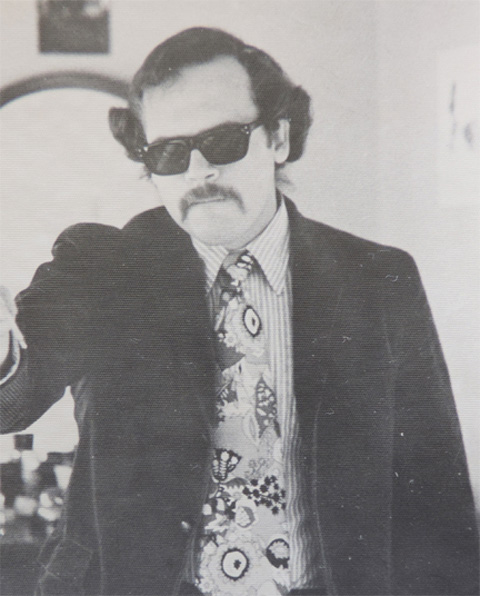
When Ed Abbey died, just five years later, in March 1989, Bill and I attended the private funeral for our friend outside Tucson at Saguaro National Monument. On the long drive from Moab, we shared our Ed Abbey stories and learned more about Ed, about each other, and about ourselves as we made our pilgrimage to say goodbye.
Bill Benge remained my best friend for the next seventeen years, until his sudden death in Moab, on October 20, 2006. The idea that more than 33 years have passed since Ed’s departure, and 16 years since I lost Bill, is almost impossible to comprehend. I still miss them both.
Jim Stiles is publisher of The Zephyr
For another Stiles “MWG related story, check out “40 Years Later, A Monkey Wrench Gang Movie?”
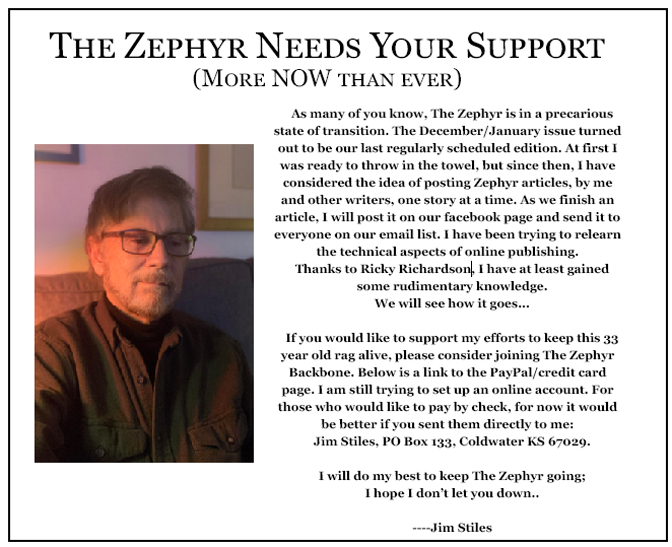
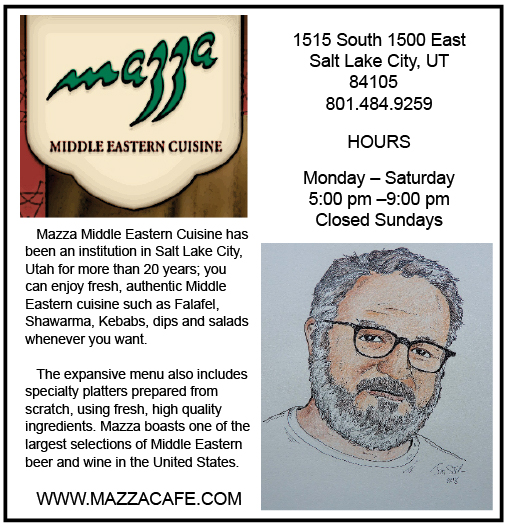

Congratulations on your first major output! It was really interesting and yes, I’d read, and owned, The Monkey Wrench Gang”. Wishing you success and if his is an example, you have no worries. Donna Andress
Thanks Jim, for continuing to share your talent, stirring up some of my fondest old memories again, with further insight into someone responsible for many of them.
Good to see you keepin’ on Jim. Don’t know what we’d do without the Zephyr. My best to you.
Great story about Benge who I met around around 1990 or 95 when he made a visit to Hopi. After our first meeting he signed me up for the print edition of the Zephyr. When I mentioned to him a few months later that I was somehow receiving this great little newspaper from Moab he confessed that he hooked me up, “for your own good”. When in Moab, I used to pick up extra copies of the Z and take them back to Hopi to pass around and share, sometimes with friends in northern Arizona and sometimes with our shop customers who were interested in the canyon country.
I did not know this story so I am glad Stiles told it. Benge was a great guy on a number of different levels and I miss him. I still have a pair of socks from his wild sock collection that Stiles gave to me after Bill died and wear them proudly on special occasions.
Long live the Z and it’s Blue Moon specials! This edition was special to me for sure.
This is from the other Steve Moore. I’m different from the respondent above. Thank you for that additional tidbit about Abbey and Benge.
I never knowingly met Abbey, but during my seasons at Natural Bridges NM in 1970 and 1971, I’m sure I came close. it was the reading of Desert Solitaire that cemented for me my own feeling for the SW and wild places in general. One of many lines from Solitaire that became one of my watchwords for the life and work of a ranger (my lifelong career) was “They’re supposed to be rangers. Make the bums range!”
I loved The Monkey Wrench Gang. I still do. Many of the descriptions vivify the experience of the landscape, just as Desert Solitaire did.
Two sidenotes about the book that could require clarification. 1. Would it really be possible for Hayduke, after winching his vehicle over the cliff near Valley of the Gods suspended from a tree (that part’s believable) to drive from there all the way to Comb Wash? I endeavor to find that spot if it really exists. 2. Abbey took liberties to rename a place or two in the book, but I’ve been to the site of his “Hidden Splendor Mine” (not its actual name) and gazed over the Cedar Mesa landscape just as his characters did in the story.
Thanks, Jim, for keeping Abbey and the Zephyr alive.
Steve Moore
back for one more stint at the Bridges this coming August
Hey Steve Moore (what a popular boomer name, went to Uni with 4 others) I was in Needles ’79-’81, and made it a part of annual pilgrimages for many years. It was there I read DS and MWG, which along with the influence of that community of parkies, severely altered the direction my life took. Just wish I hadn’t worn my old Earth First! t-shirt to threads. Dark Canyon Plateau was one of the favorite parts of my “backyard”. I miss that country hugely, but am now retired from GTNP, living in Alohaland. So glad to have those memories from the century before.
Hope your upcoming gig is a good one.
Spectacular as always, Colonel. Thanks for bowing your neck and forging on into the gale. — The OLD Chief
Very fine article Jim. I read the Ed Abbey books. This is an interesting commentary. Thanks
Very interesting and so very well written. Keep up feeding us with these great stories.
Very Nice Read! Desert Solitaire and Monkey Wrench Gang are the only books I’ve read Twice.
I’m probably one of the few people that I have a legitimate love-hate relationship with Bill Benge. He was a good cook and one time friend that represented my families successful attack on my birthright. I’d be happy to elaborate further if anybody cares to know what inheritance that the Beeson’s and Taylor’s took from me.
there’s gawtuh be a better wun-werd summary than “touching” — but THAT IT WUZZ, your (presumably succinct) summary of the lawyer-aided updated MWG. and, yes, i did read that, “in the day” — whenever that wuzz.
Good stuff…Jim is missed.